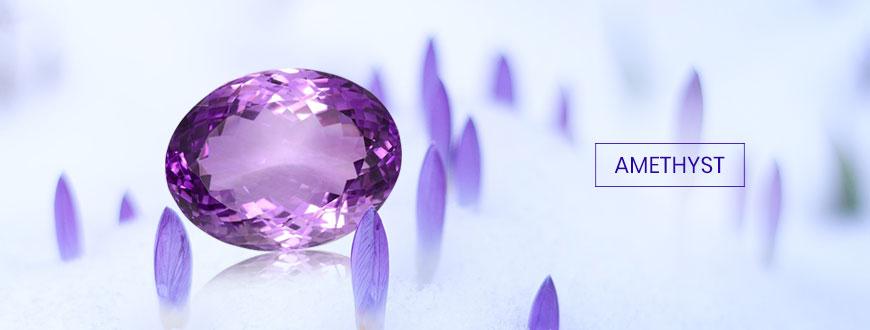Kalyan Wiki

Amethyst
Amethyst is a semi precious stone from the family of quartz. Although available in nature almost abundantly, its deep violet hue makes this one a treasured gem. Amethyst is widely used in stylish jewellery collections. The name ‘amethyst’ is derived from Koine Greek. Splitting up the word, ‘amethystos’ means"not" and ‘methysko’ translates to "intoxicate", because the stone was said to be a remedy for drunkenness. The Indian name for amethyst is ‘jamuniya’. The gem is called ‘Achlama’ in Hebrew and relates to dreaming because the stone is known to induce dreams and powerful visions. ‘Al-Halma’, its name in Arabic too, has a similar translation.
Where to find them? Highest quality amethysts are mined from Siberia, Brazil, Bolivia, Canada and Sri Lanka. Amethyst of the highest grade is called ‘Deep Siberian’. The ‘Rose de France’ is in a light lavender shade. Once considered unimpressionable, now it is very popular due to heavy marketing of this kind.
The gems and cutting are graded accordingly, i.e., Serbian, Uruguayan and Bahain, representing the best, medium and lower quality. The stone ranges in colour from a light sparkling lavender to a deep and mystifying violet. The colours are uneven in distribution, therefore a brilliant round cut is best to maintain evenness and colour quality.
Occasionally, a rare occurrence of a mixture of amethyst and citrine (a yellow coloured crystal) is found in the deposits known as ametrine (a combination of the two names). This crystal is one of a kind, a faded mix of both, a transition from amethyst to citrine, giving a dual tone to a single crystal. These are currently only found in the mines of Anahi in Bolivia.
Till the 18th century, amethyst was considered a cardinal gemstone, and was lined up as precious and rare stones. But large reserves being discovered in many parts of the world depleted its value. Still, pure and high grade amethyst is not so common, thus the price depends on the quality and intensity of colour.
Interesting excerpt All precious stones have back stories relating to their hue or powers and so does this purple beauty. Set in ancient Greece, legend has it that Bacchus, the Greek god of wine, was insulted over a petty issue. In his anger, he cursed that the first person he lays his eyes on would be devoured by a tiger. Fate bought Amethyst, a vision of beauty in front of him and as the tiger was about to pounce on her. Bacchus prayed to Diana, the Goddess of hunting, and in an instant Amethyst was changed to a white rock crystal. Regretting his short temper, Bacchus poured the grape wine in his hands onto the crystal to impart that beautiful, eye catching purple tone.
Jewellery Since this stone is such a blessing to be around, let us break down the kinds of jewellery that can utilise the powers of this gemstone.
Pendants Amethyst is a stone you might not have really noticed among elaborate mixes of rubies, emeralds and diamonds that are a common sight. This purple gem looks the most elegant as a neckpiece. Usually worn as pendants, they can be set into gold or silver. They can come in different cuts, like the princess cut or tear drop cut. The modern designs include hexagonal and pentagonal flat cut amethysts that are just stunning. Also, check for geode pendants, with the crystalline structure in the stone itself, giving it a rugged and bohemian feel.
Caring for your Amethyst
- Amethyst can lose its colour if exposed to excess light. So it is recommended to store it after use in dark containers.
- Care should be taken not to drop this stone jewellery as they are brittle and have chances of breaking to pieces in case of the larger amethyst crystal being used.
- Protect from excess moisture and always clean after wearing it to prolong life.
- Can be damaged if scraped against equally hard metals.







